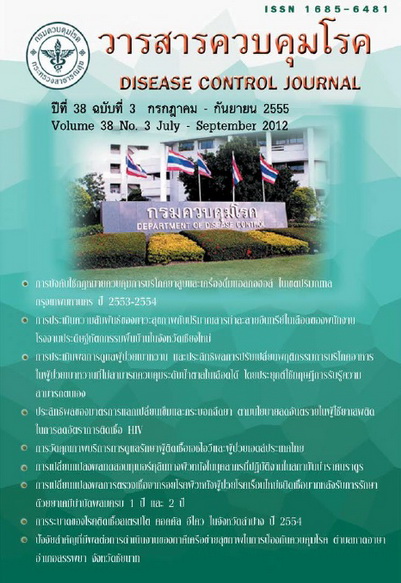Outbreak of Streptococcocus equi Infection in Lampang Province 2011
Keywords:
Streptococcus equi, outbreakAbstract
Surveillance Disease Control & Epidemiology unit at Social Medicine Department, Lampang Hospital received notification from Lampang hospital laboratory, finding 4 specimens from inpatients positive cuture for Streptoccocus equi and were confirmed by National Institute of Health, Ministry of Public Health (NIH). This raised the concern for zoonotic epidemic and promt Surveillance Rapid Response Team (SRRT) outbreak investigation. The study was conducted by reviewing medical record, physical examination, history of illness and risk factor, environmental survey and collecting specimen from animal, meat, contact cases meat shops, markets, farms, slaughter houses etc. It was found that there were 14 confirm cases of Streptoccocus equi infection, 6 patients died; fatality rate 42.8 %. Most of them were old age; Median of age were 75.3 year old and had chronic underlying disease. Clinical manifestation were Sepsis/Septicemia 85.7%, Artritis 42.8%, Septic artritis 14.8% and Meningitis 14.28%. Laboratory specimen form patients including Hemoculture, Synovial fluid, CSF were performed. The culture and identification result were positive for Streptoccocus equ subsp.zooepidemicus confirmed by both NIH and Microbiology science department, Chiangmai University. The risk exposed of patients were eating raw meat 85.7% such as raw pork 85.7%, raw beef 57.14%, raw buffalo meat 28.6%. Food meal such as Laab dib(raw chop meat mixed) 85.7%, Luu or Saa (with blood) 85.7%, Naem dib(ferment sausage) 50%. Environmental investigation had no any relation with horse or other animals. The result for laboratory environmental investigation were negative culture for identification of Streptoccocus equi. Disease control measure including strengthening surveillance, survey & examine raw meat commercial, slaughter house should be strengthened. Also active case finding and active health education, improve food sanitation, risk communication in patients community and big campaign about disease getting from raw meat should be promoted. After follow up the outbreak, there were no new cases.
Downloads
References
2. Barnham M, Cole G, Efstratiou A, Tagg JR, Skjold SA. Characterization of Streptococcus zooepidemicus (Lancefield group C) from human and selected animal infections. Epidemiol Infect. 1987; 98(2): 171-82.
3. Krauss H, Weber A, Appel M, Enders B, Isenberg HD, Schiefer HG, Slencza W, von GraevenitzA, Zahner H. Zoonoses; Infectious DiseasesTransmissible from Animals to Humans. Third. Washington, D.C., ASM Press; 2003. p. 456.
4. Chalker VJ, Brooks HW, Brownlie J. The association of Streptococcus equi subsp. zooepidemicus with canine infectious respiratory disease. Vet Microbiol. 2003; 95: 149-156
5. Downar J, Willey BM, Sutherland JW, Mathew K, Low DE. Streptococcal meningitis resulting from contact with an infected horse. J Clin Microbiol. 2001; 39: 2358-2359.
6. Bradley SF, Gordon JJ, Baumgartner DD, Marasco WA, Kauffman CA. Group C streptococcal bacteremia: analysis of 88 cases. Rev
Infect. Dis1991; 13(2): 270-80.
7. Collazos J, Echevarria MJ, Ayarza R, de Miguel J. Streptococcus zooepidemicus septic arthritis: case report and review of group C streptococcal arthritis. Clin Infect Dis. 1992; 15(4): 744-6.
8. Yuen KY, Seto WH, Choi CH, Ng W, Ho SW, Chau PY. Streptococcus zooepidemicus (Lancefield group C) septicaemia in Hong Kong. J Infect. 1990; 21(3): 241-50.
9. Hashikawa S, Iinuma Y, Furushita M, Ohkura T, Nada T, Torii K, Hasegawa T, Ohta M. Characterization of group C and G streptococcal strains that cause streptococcal toxic shock syndrome. J Clin Microbiol. 2004; 42: 186-192.
10. Ferrandiere M, Cattier B, Dequin PF, Hazouard E, Legras A, Perrotin D. Septicemia and meningitis due to Streptococcus zooepidemicus. Eur J Clin Microbiol Infect Dis. 1998; 17: 290-291
11. Ural O, Tuncer I, Dikici N, Aridogan B. Streptococcus zooepidemicus meningitis and bacteraemia. Scand J Infect Dis. 2003; 35 (3): 206-7
12. Eyre DW, Kenkre JS, Bowler IC, McBride SJ. Streptococcus equi subspecies zooepidemicus meningitis--a case report and review of the literature. Eur J Clin Microbiol Infect Dis; 29(12):1459-63
13. Minces LR, Brown PJ, Veldkamp PJ. Human meningitis from Streptococcus equi subsp. zooepidemicus acquired as zoonoses. Epidemiol Infect; 139(3): 406-10
14. Rose HD, Allen JR, Witte G. Streptococcus zooepidemicus (group C) pneumonia in a human.J Clin Microbiol.1980; 11(1):76-8
15. Edwards AT, Roulson M, Ironside MJ. A milkborne outbreak of serious infection due to Streptococcus zooepidemicus (Lancefield Group C). Epidemiol Infect. 1988; 101(1): 43-51
16. Kuusi M, Lahti E, Virolainen A, Hatakka M, Vuento R, Rantala L, et al. An outbreak of streptococcus equi subspecies zooepidemicus associated with consumption of fresh goat cheese. BMC Infect Dis. 2006; 6: 36
17. Bordes-Benitez A, Sanchez-Onoro M, Suarez-Bordon P, Garcia-Rojas AJ, Saez-Nieto JA, Gonzalez-Garcia A, et al. Outbreak of Streptococcusequi subsp. zooepidemicus infections on the island of Gran Canaria associated with the consumption of inadequately pasteurized cheese. Eur J Clin Microbiol Infect Dis. 2006; 25(4): 242-6
Downloads
Published
How to Cite
Issue
Section
License
Articles published in the Disease Control Journal are considered as academic work, research or analysis of the personal opinion of the authors, not the opinion of the Thailand Department of Disease Control or editorial team. The authors must be responsible for their articles.






